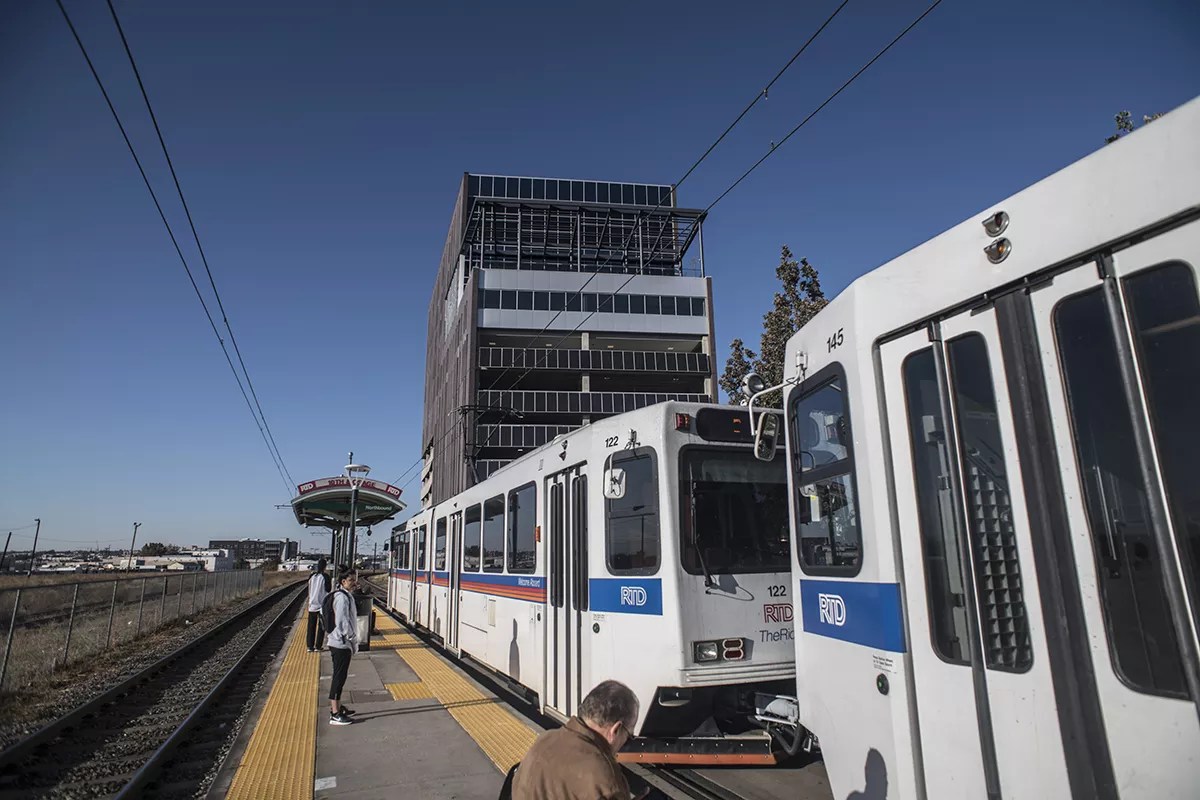
Evan Semón

Audio By Carbonatix
Sandra Mader works three jobs and doesn’t have a car, so she’s reliant on RTD to get her from place to place.
Mader walks to one of her jobs; for another, she takes the bus to Arvada. Both of those treks are usually painless, she says. But for her third job at a mail center, Mader must take the E Line, a light rail line that runs from downtown Denver to the Denver Tech Center.
“I have to get up at 4:15 a.m., walk twenty minutes to catch a bus to get to the light rail, and wait another 25 minutes to get that,” Mader says. “Assuming the light rail isn’t canceled or thirty minutes late, I then sit on it for one to two hours – and even then, I still end up being late.”
Since last summer, RTD has been performing unexpected safety fixes along the Southeast Corridor rail lines, after the agency adopted a new safety metric in March 2023 and found that many of the rail lines had degraded to unsafe levels. Those lines include the E Line that Mader depends on for her commute. Trains were cut back to once per hour in May of last year, but passengers reported that even with such a limited schedule the trains were almost always late.
“They just explained, ‘Oh, we’re adopting new standards,'” Mader says. “I don’t mind adopting new standards, but if it doesn’t help me get to work on time, I don’t see what the point is.”
To fix the safety issues related to degraded rail lines, RTD has had to implement slow zones. The E, H, R and D lines are all currently impacted, according to the RTD speed restrictions dashboard. Mader’s workplace is near the Dry Creek stop on the E Line in Greenwood Village, where there has been a slow zone for months, but that slow zone will soon be lifted.
Starting January 19, the E and H lines will be restored to fifteen-minute frequencies as part of RTD’s tri-annual service changes. But Mader will believe it when she sees it after dealing with nine months of inaccurate schedules. “I just want to get work on time and have faith in the public transportation system,” she says.
And keeping the faith hasn’t been easy.
Her Greenwood Village job at the mail center is time-sensitive, and she must be there by 7:30 a.m. Mader intentionally lives close to Alameda Avenue so she can use the 3, 11 or 14 bus lines to get to the Broadway and Alameda light rail stations, where she connects to the E Line to go further south. She’s found the 3 to be the most reliable and says the 11 and 14 are useful on the weekdays, but not if she has a weekend shift.
Lately, she hasn’t been able to rely on the 14 at all, because the bus route only leaves a three-minute gap between the scheduled drop-off and when the light rail is set to leave Broadway and Alameda – and that’s if everything is running on time.
“I’ve been using public transportation for about twenty years, more or less,” Mader says. “I’ve learned that you need to give it a five-to-ten-minute window because of snow, accidents, ADA disabilities and other incidents that might pop up. I was taking the 14 to the light rail, but I would constantly miss it because it would be five minutes later than what the schedule said.”
She often tries to get the 6:09 a.m. train at Broadway and Alameda, which would drop her off at the Dry Creek station by 6:37 a.m. if all went well. However, the E Line train Mader takes is on the same track as the H Line, which is usually around twenty minutes late. The H Line’s delay then pushes back the E train, she says.
Once Mader makes it on the train, stops and delays continue. She never knows if she and her fellow riders will be stuck for fifteen minutes, thirty minutes or an hour.
“You just don’t know what kind of day it’s going to be,” Mader says. “My plan, and it’s usually helped me pretty well up to this point, is to be there extremely early…and have some backup time. But that doesn’t seem to be helping with whatever’s happening with the E Line.”
Sometimes Mader has to get off at an earlier station to request an Uber ride, but the random time of the delays make that difficult, too. It’s also an expensive backup plan for her, since she is saving up to buy a condo.
According to Mader, light rail operators don’t know how long delays or slowdowns will last, so a five-minute delay could turn into a ten- or thirty-minute delay. “It’s hard to guess and say, ‘Okay, at this point I should just get off and take an Uber,'” she notes.
Mader expects service changes to bus line schedules will ease her commute to Arvada, but she doesn’t think changes will help shorten her time on or waiting for the light rail as construction is still occurring on rail lines in active slow zones.
The rail schedule hasn’t been accurate for Mader, who believes that increasing the frequency of the E Line to fifteen minutes, though exciting in theory, probably won’t pan out. The increased frequency only occurs after 6 a.m., anyway, and Mader has usually started her commute by then.
“I consider myself a fairly reasonable person. I get that things happen,” Mader says. “But this has been going on for nine months, and there’s no solution. …It’s very frustrating, because they say things are going to get fixed, and then they just seem to get worse.”
RTD did not respond to requests for comment.